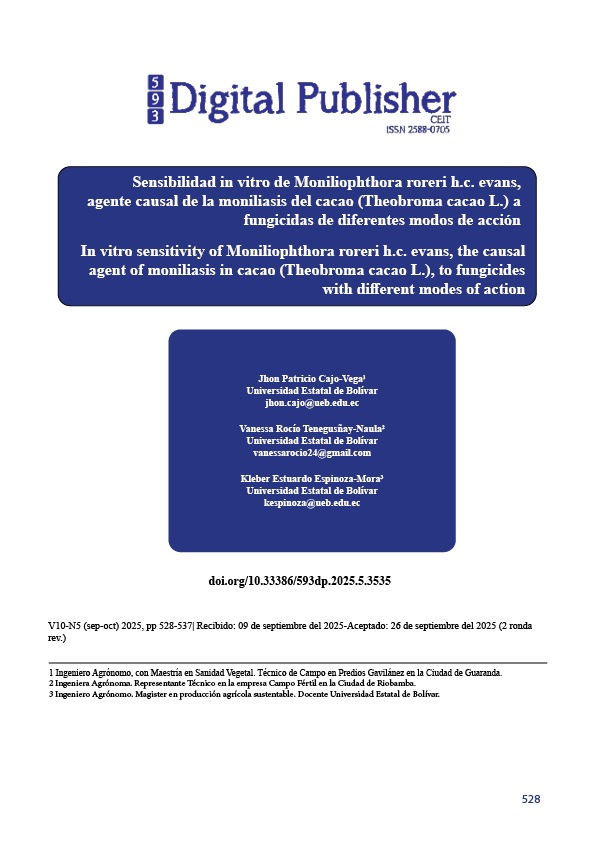In vitro sensitivity of Moniliophthora roreri h.c. evans, the causal agent of moniliasis in cacao (Theobroma cacao L.), to fungicides with different modes of action
Main Article Content
Abstract
Moniliophthora roreri is an aggressive basidiomycete fungus that affects cocoa fruits in Latin American countries, causing losses of up to 80% of the annual harvest. Its ability to infect with a single spore and produce millions of them makes frosty pod rot a serious phytosanitary problem. The objective of this study was to determine the in vitro sensitivity of Moniliophthora roreri H.C. Evans, the causal agent of frosty pod rot in cacao (Theobroma cacao L.), to fungicides with different modes of action. The research was carried out in the Phytopathology Laboratory of the Faculty of Natural Resources at the Escuela Superior Politécnica de Chimborazo, located at 2850 m a.s.l. Eight strains of Moniliophthora roreri isolated from cocoa fruits from the cantons of Francisco de Orellana and Joya de los Sachas, corresponding to the Nacional, CCN51, and Super Árbol genotypes, were used. Six active ingredients were evaluated in modified V8 medium at concentrations ranging from 0.01 to 100 ppm. Mycelial discs were incubated at 28 ± 2 °C. The mycelial growth rate (MGR) was measured, the ED50 was calculated, and the data were analyzed using ANOVA and Tukey’s test at 5%. The results showed significant differences among strains (p < 0.001). Strain 2 exhibited the highest MGR at 100 ppm (2.01 mm/day), while strain 8 recorded the lowest value (0.56 mm/day). At 1 ppm, strain 6 reached 4.22 mm/day compared to 2.46 mm/day in strain 4, confirming variability in sensitivity. It is concluded that the genetic variability of M. roreri influences its sensitivity to fungicides and that resistance depends on both the active ingredient and the cocoa genotype, reinforcing the need for integrated management programs.
Downloads
Article Details

This work is licensed under a Creative Commons Attribution-NonCommercial-ShareAlike 4.0 International License.
1. Derechos de autor
Las obras que se publican en 593 Digital Publisher CEIT están sujetas a los siguientes términos:
1.1. 593 Digital Publisher CEIT, conserva los derechos patrimoniales (copyright) de las obras publicadas, favorece y permite la reutilización de las mismas bajo la licencia Licencia Creative Commons 4.0 de Reconocimiento-NoComercial-CompartirIgual 4.0, por lo cual se pueden copiar, usar, difundir, transmitir y exponer públicamente, siempre que:
1.1.a. Se cite la autoría y fuente original de su publicación (revista, editorial, URL).
1.1.b. No se usen para fines comerciales u onerosos.
1.1.c. Se mencione la existencia y especificaciones de esta licencia de uso.
References
Baibakova, E. V., Nefedjeva, E. E., Suska-Malawska, M., Wilk, M., Sevriukova, G. A., & Zheltobriukhov, V. F. (2019). Modern fungicides: Mechanisms of action, fungal resistance and phytotoxic effects. https://pesquisa.bvsalud.org/portal/resource/pt/sea-188040
Carmona, M., & Sautua, F. (2017). La problemática de la resistencia de hongos a fungicidas. Causas y efectos en cultivos extensivos. Agronomía & Ambiente, 37(1). http://agronomiayambiente.agro.uba.ar/index.php/AyA/article/view/60
Solís, J. L., Zamarripa, A., Pecina Quintero, V., Garrido Ramírez, E., & Hernández Gómez, E. (2015). Evaluación agronómica de híbridos de cacao (Theobroma cacao L.) para selección de alto rendimiento y resistencia en campo a moniliasis. Revista mexicana de ciencias agrícolas, 6(1), 71-82.
Tenegusñay, V. R. (2022). Sensibilidad in vitro de Moniliophthora roreri HC Evans, agente causal de la moniliasis del cacao (Theobroma cacao L.) a fungicidas de diferentes modos de acción. http://dspace.espoch.edu.ec/handle/123456789/18365
Torres, M., Quevedo, I., Ortiz, C. F., del Carmen Lagúnez, L., Nieto, D., & Pérez, M. (2019). Control químico de Moniliophthora roreri en México. Biotecnia, 21(2), 55-61.




